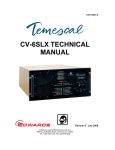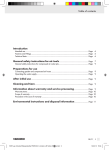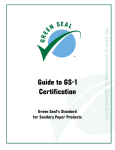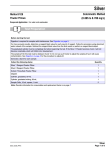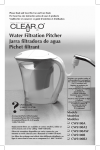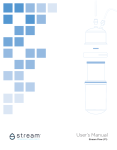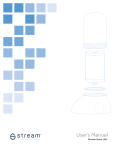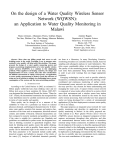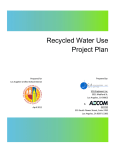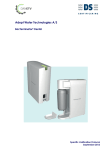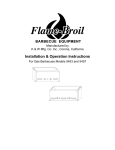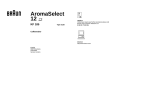Download 2013 CCR - Corona Department of Water & Power
Transcript
Consumer Confidence Report 2013 For the year 2012 Corona Department of Water and Power “Protecting Public Health” 2 Consumer Confidence Report 2013 (for year 2012) Message from the General Manager T he Department of Water and Power provides our customers with water that meets or exceeds the standards set by State and Federal Law. This report lists the types and amounts of key elements in your water supply, their likely sources and the maximum contaminant level (MCL) that the United States Environmental Protection Agency considers safe. We utilize a multi-barrier treatment process to assure safe drinking water is delivered to your home or place of business. The Department of Water and Power’s mission is to “Protect Public Health;” we work diligently to provide you with the highest quality product and service. We are proud to provide our annual report to you. Information contained in this annual report includes required statistics and information on water quality, provided to our customers in order to help them make informed choices about the water they drink. This report not only reflects our ability to meet health standards, it also demonstrates our commitment to you that we will always provide you with the best that we can offer. In addition to required elements, the report provides an opportunity for the Department of Water and Power to share information with our customers about our operations, accomplishments and future. Over the past year, we have completed $20 million in projects, launched a new public website – www.CoronaDWP.org, completed two major expansions of our reclaimed water system, installed a demonstration garden of water-wise plants at City Hall, began the update of our water master plan, and obtained $1.65 million in grant funds for future projects. Looking forward, this year we will see the groundbreaking on a new reservoir, to enhance water supply reliability, reduce energy use and provide enhanced fire flow protection; continued planning efforts for groundwater recharge and use of reclaimed water; and the implementation of a major software program – our enterprise asset management system – to help us proactively maintain our assets through their full life cycle and forecast future needs. Our Department takes pride in our product and facilities. The Department of Water and Power invites you to attend a tour of our facilities. In the last year, we hosted students, residents and business leaders on tours of some of our major facilities. The tour offers a chance for participants to get a “behind-the-scenes” look at the facilities that provide reliable water and waste water services that our community depends on to thrive. I invite you to contact me with any questions on this report or if you require additional information. Jonathan Daly General Manager 951-736-2477 www.CoronaDWP.org his report not only reflects our ability to meet health standards, it also demonstrates our “Tcommitment to you that we will always provide you with the best that we can offer. ” 3 www.CoronaDWP.org Corona’s Water Sources In 2012, Corona residents and businesses used approximately 11.4 billion gallons of drinking water. Groundwater wells owned and operated by the City of Corona provided 53% of our water supply. Another 39% came from the Colorado River by way of Lake Mathews. The final 8% is from the State Water Project in Northern California, coming to us via the California Aqueduct. Water Treatment Processes The water from the Colorado River requires treatment to remove and inactivate harmful organisms. This process is accomplished using the City of Corona’s two surface water treatment facilities: the Sierra Del Oro and Lester Water Treatment Facilities. These facilities incorporate the use of coagulant aids which bind small particles together to remove them through multimedia filtration and disinfection. Through independent laboratory testing, 100% of the samples taken in 2012 were free of harmful organisms. The Department of Water and Power disinfects the distribution system with monochloramines (a ratio of chlorine and ammonia). This allows us to achieve a long-lasting chlorine residual and reduce the production of disinfection byproducts. Disinfection byproducts are formed when disinfectants (i.e. chlorine and monochloramines) react with naturally occurring organic matter in water. Blending The Department of Water and Power has five active blending facilities that blend water with low nitrate, fluoride, perchlorate and Total Dissolved Solids with the remaining groundwater sources to deliver safe, reliable drinking water to your tap. About half of the groundwater pumped in Corona is sent through a state-of-the-art reverse osmosis membrane treatment facility, the Temescal Desalter. This facility incorporates nitrate and Total Dissolved Solids (TDS) removal, and also provides disinfection. Lester Water Treatment Facility You will notice in the tables of detected contaminants that the groundwater exceeds the primary standard for nitrate and perchlorate. The Department of Water and Power is required by law to report the range of all samples monitored, as well as the average concentration delivered to your tap. The averages are much lower because the Department of Water and Power blends water from several sources to meet water quality standards. The blending stations are continuously monitored and routinely sampled to ensure that the water delivered to your tap meets all health 4 standards with a safety margin of no less than 10%. Please refer to the “Treated Average System Water” column in the tables at the end of the report for a more accurate representation of system water quality. For more information about fluoridation, oral health, and current issues visit: www.cdph.ca.gov/certlic/drinkingwater/Pages/Fluoridation.aspx. Reclaimed Water To improve water supply reliability for the City, the Department of Water and Power developed and built our reclaimed water system in 2006. California and our region face many challenges that affect our drinking water supply, such as periodic drought, a growing population and environmental constraints. Utilizing reclaimed water to help meet water demands for the City reduces the impact of imported water supply shortages and costs. The reclaimed water system uses highly treated wastewater from our state-ofthe-art water reclamation facilities and distributes it throughout the reclaimed water system. The reclaimed system is completely separate from the drinking Consumer Confidence Report 2013 (for year 2012) water system, utilizing purple pipes, sprinklers and signage to denote its location. Reclaimed water is used primarily on landscaping at parks, schools and parkway areas, and even in a commercial building for trap priming. By re-using water that would normally have been wasted, we save potable water for our homes and businesses. The City of Corona’s infrastructure for the reclaimed water system consists of approximately 44 miles of pipeline, three storage reservoirs, and three pump stations. In 2012, the City expanded its reclaimed water system with two new projects – the Masters Drive and City Park Extensions. In addition, the City is currently exploring additional ways to use reclaimed water, from cooling towers to dual plumbing for commercial facilities. The reclaimed water system produced 1.41 billion gallons of reclaimed water in 2012 and we are continually adding new customers. Grants – We’re Working For You! The City received a $300,000 grant from the Bureau of Reclamation to install a pilot project of “smart” meters for a portion of our service area. Smart meters are meters with advanced metering technology capabilities that will assist the City with its water conservation efforts. The meters will improve the City’s ability to serve its customers and manage its water losses by providing the technology to make notifications for leaks through real-time meter reading capabilities. This project is 5 www.CoronaDWP.org very exciting and will result in increased customer service and conservation of our region’s precious water resources. Challenges to Our Imported Water Supplies Because of a dry winter, California faces a major challenge in meeting the water needs for the State. Corona, like much of California, depends on imported water to meet demands for its customers. In 2012, 47% of our water supply was imported through the Metropolitan Water District: 8% from the State Water Project (SWP) in Northern California and 39% from the Colorado River. Pumping Restrictions on the Delta Pumping restrictions on the Delta due to the Endangered Species Act remain in effect. The State is required to maintain certain flow and volume for the Delta in order to maintain designated habitat and protect endangered species such as the Delta Smelt. It is difficult to meet 100% of requested deliveries due to these pumping restrictions. After a dry winter, neither the SWP nor the Central Valley Project (CVP) are able to deliver 100% of water requests this year. As of March 2013, the projected delivery allocation from the SWP is 35% of requests, and only 20% of agricultural requests and 70% of municipal requests from the CVP. Drought on the Colorado River The Colorado River has been in the midst of a drought for over a decade. Water from the Colorado River is shared per the 1922 Colorado River Compact, which allocates water to seven states and Mexico. The Upper Colorado region states, consisting of Colorado, Utah, New Mexico and Wyoming, receive 7.5 million acre-feet of water per year. Lower region states, including Arizona, California and Nevada, receive 7.5 million acre-feet of Colorado River water per year; California receives the largest share at 4.5 million acre-feet per year. Mexico receives 1.5 million acre-feet per year. (An acre-foot of water is 325,829 gallons. This is enough water for two typical households for a whole year.) For many years, California has received its share of Colorado River water and up to 50% of the surplus of water available from other states not using their full share. Due to the drought and other states now taking their fair share, the surplus of water California once received is no longer available. Many experts believe the Colorado River has been over-allocated; the amounts set in the 1922 compact were set for levels in wet years, and may not be normal volumes the Colorado River can sustain. 6 Consumer Confidence Report 2013 (for year 2012) clothes washer. The Department of Water and Power offers free devices and rebates – so take advantage of them. It’s an easy way to save water without changing any habits. Do you have a leaky toilet that needs to be fixed? If it’s caused you to go over your water budget, fix it and we can give you a credit on your water bill through our Variance Program. You can help reach the goal and save money, too. Lake Mead Delta Water Package and 20% by 2020 The Delta Water Package, passed in 2009, is a comprehensive legislative package on water policy. It came from the need for California to have a sustainable, reliable water supply for residents and businesses. As part of this legislative package, Senate Bill No. 7 requires all urban water agencies to reduce statewide per capita water consumption 20% by 2020. Corona is working towards its goal; with an eye on continued water efficiency we are sure to reach it. So how can you help reach our goal? Reduce your showers by a few minutes, install a low-flow showerhead, faucet aerator, or high-efficiency About 60% of all water use in Corona is for landscaping; so there’s a huge opportunity for savings outdoors. We live in a semi-arid climate that only receives about 12 inches of rainfall a year, but turf requires about 52 inches of water per year. Replace your old sprinkler controller with a “smart” timer – it adjusts for the weather, so you can set it and forget it. Try taking a minute off of each of your stations this summer – your grass can handle it. Give your yard a week or two to adjust, and then try taking another minute off. Or consider installing drip irrigation in your planter areas, or even removing some of your turf and replacing it with low water-using plants. Rebate programs are available, and we also offer landscape classes that help show you how you can do it! Free up your Saturday morning mowing and edging time by eliminating grass – low maintenance means big benefits: less work and a lower water bill. 7 www.CoronaDWP.org Water: An Undervalued Resource Tour Our Facilities Only about 3% of the earth’s water is fresh water that is used for drinking; two-thirds of that water is stored in ice caps and glaciers. That’s a small amount of water for everyone on the planet to share. Yet many of us don’t think twice about the water that we use every day. All too often, treated, imported water can be seen running down the storm drain – wasted. Water is a precious resource; we all need it to live. Where there is water, there is life. The last few years have proven that water availability is not guaranteed. In past years, the snowpack in the Sierra Nevada mountains has been able to fill the State’s reservoirs and keep the lifeblood of California flowing; but recently, the snowpack has been well below average, causing reduced deliveries across the State. It’s time to take our water future into our own hands, use our resources efficiently, and focus on sustainable water supplies. A lot goes on behind the scenes to provide our customers with clean and affordable drinking water. Do you want to learn more about how your water is treated and delivered? Are you interested in seeing how we produce reclaimed water? Join us on a tour of DWP facilities. Here are some comments received from past tour participants: “There is so much that goes on behind the scenes to deliver our water.” “The key to conservation is education. Need to really get the word out on all sources.” “I feel our City is in complete capable hands.” Our Water Resources Team is here to help you save water. We offer landscape checkups, rebates, landscape classes, and more. Please contact the Water Resources Team at 951-736-2234 or by email at StopTheDrop@ discovercorona.com. Make every drop count – use water efficiently. Facility Tour If you have any questions about our water supply or water reclamation facilities, or you’re just curious, we encourage you to attend one of our quarterly facility tours. Contact our Water Resources Team at 951‑736-2234 or by e-mail at StopTheDrop@ discovercorona.com to sign up for an upcoming tour. You must be at least 18 years old and a customer of the Department of Water and Power to attend. 8 Tiered Rates and Water Budgets Tiered rates and water budgets promote efficient water use, resource conservation, provide fair rates and are an equitable way to share resources. The water budget provides each customer with a budget that uses the customer’s unique characteristics. All Department of Water and Power customers receive a monthly water budget. Residential customers receive a water budget that has two components: an indoor budget and an outdoor budget. The indoor budget provides 60 gallons per person per day in the billing cycle, based on the number of people in the home. The default indoor budget for a single family home is based on four people per household, and two people Tiered Rate Water Budgets for each unit in a multi-family residence. The outdoor budget is based on daily weather data and the amount of landscaped area. The outdoor budget will decrease during cooler months and increase in warmer summer months, because more water is needed by the landscape when the weather is warm, and less is needed when it is cool and we receive rain. Consumer Confidence Report 2013 (for year 2012) Commercial and industrial mixed use and structure accounts (accounts serving a building and irrigation or just a building) receive a budget based on a three-year rolling average. For accounts that have not been established for more than a year, the budget is the actual water use in the first year. Landscapes with a dedicated meter receive an outdoor budget based on landscaped area and weather data, just like residential accounts. Variance Program The Department of Water and Power has a variance program to request changes to your water budget. You can use the variance program if the number of people in the residence is greater than the default budget, or a measurement shows the irrigated area estimate was not sufficient. A variance may also be granted if you find and fix a leak on your property. Forms are available online at www.CoronaDWP.org, at City Hall, or can be mailed to you by calling our Customer Service Team at 951-736-2321. 9 www.CoronaDWP.org Did you know? • There are 748 gallons of water in one unit. • One acre-foot of water equals 325,829 gallons or 435.6 billing units. • One acre-foot of water can supply two typical families with water for a whole year. • A leaky toilet can waste between 30 to 500 gallons of water per day. From Your Drain to the Environment – Keep it Clean While water reclamation treatment removes most pollutants, even trace amounts of some substances may be harmful to the environment. The best solution is to prevent pollution from going down the drain in the first place. Dispose of unwanted medicine properly…No Drugs Down the Drain! For years, unwanted medicine was flushed down the drain to protect children and pets from accessing it, and to ensure against illegal recovery of controlled substances. Today, there are better options. The City of Corona Department of Water and Power and the Police Department are working together to protect our environment from the harmful effects of improperly discarded, unused medications. For your convenience, a pharmaceutical disposal bin has been placed at the Corona Police Department lobby located at 730 Corporation Yard Way. For more information, please call 951-736-2330. Keep drains free of FOG – fats, oils and grease When washed down the drain, cooking fats, oils and grease, or “FOG,” can block sewer lines, causing raw sewage to back up into your home or into neighborhood streets and storm drains. Overflows can be costly, and pose health and environmental hazards. Keep your sewer lines FOGfree by scraping cooking fats into the garbage or into your food scrap recycling bin, where available – not down the drain. 10 General Water Quality Information The sources of drinking water (both tap and bottled water) include rivers, lakes, streams, ponds, reservoirs, springs, and wells. As water travels over the surface of the land or through the ground, it dissolves naturally-occurring minerals and, in some cases, radioactive material, and can pick up substances resulting from the presence of animals or from human activity. Contaminants that may be present in source water include: •M icrobial contaminants, such as viruses and bacteria, that may come from sewage treatment plants, septic systems, agricultural livestock operations, and wildlife. Consumer Confidence Report 2013 (for year 2012) production, and can also come from gas stations, urban stormwater runoff, agricultural application and septic systems. • R adioactive contaminants, that can be naturally-occurring or be the result of oil and gas production and mining activities. In order to ensure that tap water is safe to drink, the U.S. Environmental Protection Agency (USEPA) and the California Department of Public Health (CDPH) prescribe regulations that limit the amount of certain contaminants in water provided by public water systems. CDPH regulations also establish limits for contaminants in bottled water that provide the same protection for public health. Drinking water, including bottled water, may reasonably be expected to • Inorganic contaminants, such as salts and metals, that can be naturally- contain at least small amounts of some contaminants. The presence of occurring or result from urban stormwater runoff, industrial or domestic wastewater discharges, oil and gas production, mining or farming. • P esticides and herbicides, that may come from a variety of sources such as agriculture, urban stormwater runoff, and residential uses. contaminants does not necessarily indicate that water poses a health risk. More information about contaminants and potential health effects can be obtained by calling the USEPA’s Safe Drinking Water Hotline (1-800-426-4791). •O rganic chemical contaminants, including synthetic and volatile organic Some people may be more vulnerable to contaminants in drinking chemicals that are byproducts of industrial processes and petroleum water than the general population. Immuno-compromised persons such as persons with cancer undergoing chemotherapy, persons who have 11 www.CoronaDWP.org undergone organ transplants, people with HIV/AIDS or other immune system disorders, some elderly, and infants can be particularly at risk from infections. These people should seek advice about drinking water from their health care providers. USEPA/Centers for Disease Control (CDC) guidelines on appropriate means to lessen the risk of infection by Cryptosporidium and other microbial contaminants are available from the Safe Drinking Water Hotline (1-800-426-4791). Nitrate Nitrate in drinking water at levels above 45 mg/L is a health risk for infants of less than six months of age. Such nitrate levels in drinking water can interfere with the capacity of the infant’s blood to carry oxygen, resulting in a serious illness; symptoms include shortness of breath and blueness of the skin. Nitrate levels above 45 mg/L may also affect the ability of the blood to carry oxygen in other individuals, such as pregnant women and those with certain specific enzyme deficiencies. If you are caring for an infant, or you are pregnant, you should ask advice from your health care provider. Lead If present, elevated levels of lead can cause serious health problems, especially for pregnant women and young children. Lead in drinking water is primarily from materials and components associated with service lines and home plumbing. The City of Corona is responsible for providing high quality drinking water, but cannot control the variety of materials used in plumbing components. When your water has been sitting for several hours, you can minimize the potential for lead exposure by flushing your tap for 30 seconds to 2 minutes before using water for drinking or cooking. If you are concerned about lead in your water, you may wish to have your water tested. Information on lead in drinking water, testing methods, and steps you can take to minimize exposure is available from the Safe Drinking Water Hotline or at http://www.epa. gov/safewater/lead. Chromium-6 On July 27, 2011, the Office of Environmental Health Hazard Assessment (OEHHA) established a public health goal (PHG) for chromium-6 (hexavalent chromium) of 0.02 parts per billion (ppb). The PHG will contribute to CDPH’s development of a primary drinking water standard (maximum contaminant level, MCL) that is specific for chromium-6. Please refer to http://www.cdph.ca.gov/certlic/drinkingwater/ Pages/Chromium6.aspx for more information. 12 Consumer Confidence Report 2013 (for year 2012) Source Water Assessment In accordance with the Federal Safe Drinking Water Act (SDWA), the State Department of Public Health Division of Drinking Water and Environmental Management developed a program, called the Drinking Water Source Assessment and Protection (DWSAP) Program, to assess the vulnerability of drinking water sources to contamination. Assessments of the drinking water sources for the City of Corona were completed most recently in February 2012. The assessment concluded that the City of Corona’s sources are considered most vulnerable to the following activities not associated with any detected contaminants in the water supply: automobile – gas stations, chemical/petroleum pipelines, chemical/ petroleum processing/storage, dry cleaners, historic gas stations, machine shops, metal plating/finishing/fabricating, mining – sand/gravel, National Pollutant Discharge Elimination System (NPDES) and Waste Discharge Requirements (WDR) permitted discharges, plastics/ synthetics producers, septic systems – low density [<1/acre], sewer collection systems, underground storage tanks 100% of the samples taken in 2012 were free from harmful organisms. – confirmed leaking tanks, utility stations – maintenance areas, and wastewater treatment plants. A copy of the complete assessments are available through the City of Corona’s City Clerk’s office at 400 S. Vicentia, Corona, CA 92882, or by using the online Public Records Request form at www.CoronaDWP.org. Lead and Copper Rule Monitoring The Lead and Copper Rule (LCR) was developed to protect public health by minimizing lead and copper levels in drinking water. The LCR established an action level of 15 parts per billion (ppb) for lead and 1.3 parts per million (ppm) for copper based on the 90th percentile level of tap water samples collected. Lead and copper are sampled on a mandated three year testing cycle with sampling conducted at the customer’s tap. Parameter Units State MCL PHG State DLR Date Sampled 90th Percentile No. Sites Sampled No. Sites Exceeding AL Lead ppb AL=15 0.2 5 2011 <5 50 2 Copper ppm AL=1.3 0.3 0.05 2011 0.1 50 0 AL Allowable Levels DLR Detection Limits for purposes of Reporting MCL Maximum Contaminant Level PHG Public Health Goal ppb Parts per billion or micrograms per liter (μg/L) ppm Parts per million or milligrams per liter (mg/L) 13 www.CoronaDWP.org Please see pages 19-21 for key to abbreviations and footnotes Primary Standards – Mandatory Health-Related Standards Parameter Units State MCL [MRDL] Combined Filter Effluent Turbidity NTU TT 0.3 % 95(a) Combined Filter Effluent Turbidity NTU TT 0.3 % 95(a) Parameter Units PHG (MCLG) [MRDLG] State DLR NA - NA - State MCL [MRDL] PHG (MCLG) [MRDLG] State DLR 5.0 (b) (0) - Range Average Water Source Major Sources in Drinking Water CLARITY Highest % < 0.3 Highest % < 0.3 0.07 Metropolitan Water District Henry J. Mills Water Treatment Plant 100% City of Corona, Lester & Sierra Del Oro Water Treatment Facilities 100% 0.14 Range Average Regulated in Distribution System Range Highest % of positive samples collected in any one month = 0.8% Average Total number of positive samples collected in 2012 = 1 Soil runoff Soil runoff Major Sources in Drinking Water MICROBIOLOGICAL CONTAMINANTS Total Coliform Bacteria (Total Coliform Rule) % Fecal Coliform and E. Coli (Total Coliform Rule) (c) Heterotrophic Plate Count CFU/mL (HPC) Parameter Units (0) - TT NA NA State MCL [MRDL] PHG (MCLG) [MRDLG] State DLR (c) Range Distribution System Wide: ND Average Total number of positive samples collected in 2012 = 0 Range Distribution System Wide: ND-210 Average Distribution System Wide: 3 Naturally present in the environment Human and animal fecal waste Naturally present in the environment Range Average State Project Water Colorado River Water Ground Water Treated Average System Water Major Sources in Drinking Water RADIOACTIVE CONTAMINANTS (j) Gross Alpha Particle Activity pCi/L 15 (0) 3 Uranium pCi/L 20 0.43 1 Combined Radium - 226+228 pCi/L 5 (0) NA Range ND 3-5 0-13.5 - Average ND 4 7.09 - Range ND-1 2-3 ND-16.5 - Average 1 3 5.75 - Range ND ND ND-0.008 - Average ND ND 0.002 - Erosion of natural deposits Erosion of natural deposits Erosion of natural deposits 14 Consumer Confidence Report 2013 (for year 2012) Units State MCL [MRDL] PHG (MCLG) [MRDLG] State DLR Arsenic ppb 10 0.004 2 Barium ppm 1 2 0.1 Chromium ppb 50 (100) 10 Fluoride (e, h) ppm 2 1 0.1 Nickel ppb 100 12 10 Nitrate (as N03) (d,e,k) ppm 45 45 2 Parameter Range Average State Project Water Colorado River Water Ground Water Treated Average System Water Major Sources in Drinking Water INORGANIC CONTAMINANTS Perchlorate (e, i, k) Selenium ppb ppb 6 50 6 30 Range ND 2.2 ND-3.8 ND-2 Average ND 2.2 ND ND Range ND 0.12 ND-0.15 ND Average ND 0.12 ND ND Range ND ND ND-1.7 ND Average ND ND ND ND Range 0.3-0.9 0.3 ND-0.7 ND-1.2 Average 0.7 0.3 0.4 0.3 Range ND ND ND-12 ND Average ND ND ND ND Range 3.2 ND ND-100 ND-32 Average 3.2 ND 38 15 Range ND ND ND-11 ND Average ND ND ND ND Range ND ND ND-6.6 ND Average ND ND ND ND 4 5 Erosion of natural deposits; runoff from orchards; glass and electronics production wastes Discharges of oil drilling wastes and from metal refineries; erosion of natural deposits Discharge from steel and pulp mills and chrome plating; erosion of natural deposits Erosion of natural deposits; water additive that promotes strong teeth; discharge from fertilizer and aluminum factories Erosion of natural deposits; discharge from metal factories Runoff and leaching from fertilizer use; leaching from septic tanks and sewage; erosion of natural deposits Perchlorate is an inorganic chemical used in solid rocket propellant, fireworks, explosives, flares, matches, and a variety of industries. It usually gets into drinking water as a result of environmental contamination from historic aerospace or other industrial operations that used or use, store, or dispose of perchlorate and its salts Discharge from petroleum, glass, and metal refineries; erosion of natural deposits; discharge from mines and chemical manufacturers; runoff from livestock lots (feed additive) 15 www.CoronaDWP.org Parameter Units State MCL [MRDL] PHG (MCLG) [MRDLG] State DLR Range Average State Project Water Colorado River Water Ground Water Treated Average System Water Range ND ND ND-30 ND Average ND ND ND ND Major Sources in Drinking Water SYNTHETIC ORGANIC CONTAMINANTS including Pesticides/PCBs Dibromochloropropane (DBCP) ppt 200 1.7 10 Banned nematocide that may still be present in soils due to runoff/leaching from former use on soybeans, cotton, vineyards, tomatoes, and tree fruit VOLATILE ORGANIC CONTAMINANTS Tetrachloroethylene (PCE) ppb 5 0.06 0.5 Trichloroethylene (TCE) ppb 5 1.7 0.5 Range ND ND ND-1 ND Average ND ND ND ND Range ND ND ND-1.9 ND Average ND ND 0.7 ND Discharge from factories, dry cleaners, and auto shops (metal degreaser) Discharge from metal degreasing sites and other factories DISINFECTION BYPRODUCTS, DISINFECTANT RESIDUALS, AND DISINFECTION BYPRODUCT PRECURSORS (m) Total Trihalomethanes (TTHMs) (n) ppb 80 NA 1 Range 12-18 - ND-1 ND-40 Average 15 - ND 19.7 Byproduct of drinking water disinfection SECONDARY STANDARDS – Aesthetic Standards Aluminum (u) ppb 200 600 50 Chloride ppm 500 NA NA Color Units 15 NA NA Manganese (f, k) ppb 50 NL=500 20 Specific Conductance (k) µS/ cm 1,600 NA NA Sulfate ppm 500 NA 0.5 Range 65-160 ND ND 80-440 Average 120 ND ND 190 Range 80-100 82-87 ND-230 20 Average 92 84 126 20 Range 1 2 ND-3 ND Average 1 2 ND ND Range ND ND ND-820 ND Average ND ND 45 ND Range 380-600 930-940 3-1,600 160 Average 490 930 1163 160 Range 27-44 210-220 ND-350 3.4 Average 36 220 178 3.4 Erosion of natural deposits; residue from some surface water treatment processes Runoff/leaching from natural deposits; seawater influence Naturally-occurring organic materials Leaching from natural deposits Substances that form ions when in water; seawater influence Runoff/leaching from natural deposits; industrial wastes 16 Consumer Confidence Report 2013 (for year 2012) Parameter Units State MCL [MRDL] PHG (MCLG) [MRDLG] State DLR Range Average State Project Water Colorado River Water Ground Water Treated Average System Water Major Sources in Drinking Water SECONDARY STANDARDS – Aesthetic Standards – continued Total Dissolved Solids (e, k, t) ppm 1,000 NA NA Turbidity Units 5 NA NA Zinc ppm 5 NA 0.05 Range 280-290 570-580 ND-1,100 54-720 Average 290 570 760 350 Range ND 0.3-0.5 ND-1.2 ND Average ND 0.4 0.1 ND Range ND ND ND-0.1 ND Average ND ND ND ND UNREGULATED CHEMICALS REQUIRING MONITORING (STATE AND FEDERAL ) Boron (p) ppm NA NL=1 ppb NA 0.02 1 Vanadium ppb NA NL=50 3 Soil runoff Runoff/leaching from natural deposits; industrial wastes Health Effects (g) Range 0.15 0.13 0.35-0.85 0.24-0.29 Average 0.15 0.13 0.53 0.26 0.1 Chromium VI (q) Runoff/leaching from natural deposits Range ND ND ND-1.1 - Average ND ND 0.46 - Range ND ND ND-10 ND-3.1 Average ND ND 4.8 ND The babies of some pregnant women who drink water containing boron in excess of the notification level may have an increased risk of developmental effects, based on studies in laboratory animals NA The babies of some pregnant women who drink water containing vanadium in excess of the notification level may have an increased risk of developmental effects, based on studies in laboratory animals 17 www.CoronaDWP.org Other Parameters Chemical Units State MCL [MRDL] PHG (MCLG) [MRDLG] State DLR Alkalinity ppm NA NA NA Calcium ppm NA NA NA Hardness ( r) ppm NA NA NA Magnesium ppm NA NA NA pH pH Units NA NA NA Potassium ppm NA NA NA Sodium (s) ppm NA NA NA Bicarbonate ppm NA NA NA Range Average State Project Water Colorado River Water Ground Water Treated Average System Water Range Average Range Average Range Average Range Average Range Average Range Average Range Average Range Average 64-86 75 16-23 20 78-110 100 12-13 12 8.2-8.6 8.4 2.8-2.9 2.8 60-67 64 - 120 120 64-65 64 260-270 270 24-25 24 8.2-8.4 8.3 4.4-4.5 4.4 85-88 86 - ND-290 207 ND-160 111 ND-700 399 ND-71 29 6.3-7.9 7.3 ND-12 3.9 ND-150 89 ND-350 250 17-100 49 3-49 20 9-170 70 ND-13 5 6.0-9.2 8 1 1 26 26 21-120 60 18 Consumer Confidence Report 2013 (for year 2012) 2013 Annual Water Quality Report for 2012 UNIT State MCL PHG (MCLG) State [MRDL] [MRDLG] DLR Range Avg/Max RAA Distribution System Wide Major Sources in Drinking Water Health Effects Language DISINFECTION BYPRODUCTS, DISINFECTANT RESIDUALS, AND DISINFECTION BYPRODUCT PRECURSORS FEDERAL RULE (m) Total Trihalomethanes (TTHMs) (n) ppb Haloacetic Acids (o) ppb 60 NA 1 Bromate (Mills WR-24 Conn.) (l) ppb 10 0.1 1 Chloramines Control of DBP precursors (TOC) ppm ppm 80 [4] TT NA [4] NA Range ND-40 RAA 19.7 Range ND-17 RAA 8.9 Range ND-11 Max RAA 3.4 Range 0.1-2.7 Max RAA 1.65 Range 2.1-2.6 1 NA 0.3 Avg 2.2 Byproduct of drinking water disinfection Some people who drink water containing trihalomethanes in excess of the MCL over many years may experience liver, kidney, or central nervous system problems, and may have an increased risk of getting cancer Byproduct of drinking water disinfection Some people who drink water containing haloacetic acids in excess of the MCL over many years may have an increased risk of getting cancer Byproduct of drinking water disinfection Some people who drink water containing bromate in excess of the MCL over many years may have an increased risk of getting cancer Drinking water disinfectant added for treatment Some people who use water containing chloramines well in excess of the MRDL could experience irritating effects to their eyes and nose. Some people who drink water containing chloramines well in excess of the MRDL could experience stomach discomfort or anemia Various natural and manmade sources Total organic carbon (TOC) has no health effects. However, total organic carbon provides a medium for the formation of disinfection byproducts. These byproducts include trihalomethanes (THMs) and haloacetic acids (HAAs). Drinking water containing these byproducts in excess of the MCL may lead to adverse health effects, liver or kidney problems, or nervous system effects, and may lead to an increased risk of cancer. 19 www.CoronaDWP.org Key to Abbreviations CFU/mL Colony-Forming Units per Milliliter DBP Disinfection Byproducts DLR Detection Limits for purposes of Reporting MBAS Methylene Blue Active Substances N Nitrogen NA Not Applicable ND Not Detected NL Notification Level NTU Nephelometri Turbidity Units pCi/L PicoCuries per liter Running Annual Average ppb Parts per billion or micrograms RAA TOC Total Organic Carbon per liter (μg/L) ppmParts per million or milligrams μS/cmmicroSiemen per centimeter or micromho per centimeter per liter (mg/L) (µmho/cm) ppt Parts per trillion or nanograms per liter (ng/L) Extended Abbreviations Maximum Contaminant Level (MCL): The highest level of a contaminant that is allowed in drinking water. Primary MCLs are set as close to the PHGs (or MCLGs) as is economically and technologically feasible. Secondary MCLs are set to protect the odor, taste and appearance of drinking water. Maximum Contaminant Level Goal (MCLG): The level of a contaminant in drinking water below which there is no known or expected risk to health. MCLGs are set by the U.S. Environmental Protection Agency. Public Health Goal (PHG): The level of a contaminant in drinking water below which there is no known or expected risk to health. PHGs are set by the California Environmental Protection Agency. Primary Drinking Water Standard (PDWS): MCLs and MRDLs for contaminants that affect health along with their monitoring and reporting requirements, and water treatment requirements. Maximum Residual Disinfectant Level (MRDL): The highest level of a disinfectant allowed in drinking water. There is convincing evidence that addition of a disinfectant is necessary for control of microbial contaminants. Maximum Residual Disinfectant Level Goal (MRDLG): The level of a drinking water disinfectant below which there is no known or expected risk to health. MRDLGs do not reflect the benefits of the use of disinfectants to control microbial contaminants. Regulatory Action Level: The concentration of a contaminant which, if exceeded, triggers treatment or other requirements that a water system must follow. Treatment Technique (TT): A required process intended to reduce the level of a contaminant in drinking water. 20 Consumer Confidence Report 2013 (for year 2012) Footnotes (a)The turbidity level of the filtered water shall be less than or equal to 0.3 NTU in 95% of the measurements taken each month and shall not exceed 1 NTU at any time. Turbidity, a measure of the cloudiness of the water, is an indicator of treatment performance. The averages and ranges of turbidity shown in the Secondary Standards were based on the treatment plant effluent. (b)Total coliform MCLs: No more than 5.0% of the monthly samples may be total coliform-positive. Compliance is based on the combined distribution system sampling from all the treatment plants. In 2012, 1593 samples were analyzed and one was positive for total coliforms. The MCL was not violated. (c)E. coli MCL: The occurrence of two consecutive total coliform-positive samples, one of which contains E. coli, constitutes an acute MCL violation. The MCL was not violated. (d)State MCL is 45 mg/L as nitrate, which is the equivalent of 10 mg/L as N. (e) Fluoride, nitrate, perchlorate, and TDS are a part of Corona’s blending remediation plan to reduce the levels being delivered to the consumer’s tap. Refer to the “Treated Average System Water” column for a more accurate representation of system water quality. See how your water is treated and delivered by attending a quarterly facility tour. (h)The City of Corona was in compliance with all provisions of the State’s Fluoridation System Requirements. This is part of the City of Corona’s blending plan to reduce the levels of fluoride being delivered to the consumers’ tap. Refer to the “Treated Average System Water” column for a more accurate representation of system water quality. (f )The high concentration of Manganese is from two groundwater wells; the City utilizes over 20 wells. Refer to the “Treated Average System Water” column for a more accurate representation of system water quality. (i) Perchlorate reporting level is 4 ppb. (g)Unregulated contaminant monitoring helps the USEPA and CDPH determine where certain contaminants occur and whether the contaminants need to be regulated. (k)This constituent was detected at high levels exceeding the MCL at the highlighted source. Please note that this water is blended with water from other sources to provide customers with the highest quality drinking water. (j) Data collected from four consecutive quarters of monitoring. 21 www.CoronaDWP.org (l)Bromate reporting level is 3 ppb and reported from Mills Filtration Plant Metropolitan Water District (MWD). Mills MWD water is blended with other Corona water sources. Please note that this water is blended with water from other sources to provide customers with the highest quality drinking water. (m)The City of Corona was in compliance with all provisions of the Stage 1/Stage 2 Disinfectants and Disinfection Byproducts Rules (D/DBPR). Stage 2 D/DBPR monitoring began in the 2nd quarter. Compliance was based on the RAA. (n)Reporting level is 0.5 ppb for each of the trihalomethanes (bromodichloromethane, bromoform, chloroform, and dibromochloromethane). (o)DLR is 1.0 ppb for each of the following: dichloroacetic acid, trichloroacetic acid, monobromoacetic acid, and dibromoacetic acid; and 2.0 ppb for monochloroacetic acid. (p)The sources that were detected for Boron are all directed to the Temescal Desalter for reverse osmosis treatment. The treated water is monitored at the effluent of the facility which is represented in the “Treated Average System Water” column. (q) Chromium VI reporting level is 1 ppb. (r)Hardness is the sum of polyvalent cations present in the water, generally magnesium and calcium. The cations are usually naturally occurring. (s)Sodium refers to the salt present in the water and is generally naturally occurring. (t)Total Dissolved Solids (TDS) is a measure of the total amount of all the materials that are dissolved in water. These minerals, both natural and anthropogenic (made by humans), are mainly inorganic solids, with a minor amount of organic material. (u)Aluminum has a secondary standard limit. In 2012 the secondary standard limit was exceeded at our Treatment Facility effluent with a Maximum Running Annual Average (Max RAA) of 500 ug/L. No consumer action is necessary since secondary standards for aluminum are established only for aesthetic effects (water color). We are continually calibrating our aluminum base coagulant to achieve the nonmandatory secondary standard limit of 200 ug/L. We expect to achieve this limit by the end of 2013. Our current Max RAA for 2013 is 210 ug/L. Free landscape check-ups help identify ways to lower your water bill. 22 Frequently Asked Questions How hard is my water? Hardness is dissolved minerals, including calcium and magnesium. This may cause a deposit or water spots on fixtures and dishes. Our average hardness is 399 ppm or 23.3 grains per gallon, classified as hard to very hard. Our water hardness can change depending on the water demand and the season. When I turn on my kitchen or bathroom faucet, the water comes out white. What is wrong? Dissolved air in the water causes a milky appearance. When you open your faucet, the pressure is relieved and this allows the air to form bubbles that rise to the top of the glass. It will clear within a minute, beginning at the bottom of the glass. The water is safe to drink. Consumer Confidence Report 2013 (for year 2012) How do I flush my water heater? We have general instructions for flushing your water heater; for specific instructions consult your user’s manual or look on the manufacturer’s website. Below are general instructions; for more information, please call 951-736-2234. 1. T urn the gas valve to “pilot.” 2. Hook up a garden hose to the water heater and find a proper location to drain the water; use caution – water will be hot when it comes out. 3. Open the valve until all of the hot water has drained from the water heater. 4. Close the valve where the garden hose is hooked up. 5. Allow the heater to fill up, and then close the cold water supply on top of heater. 6. Open up the hose bib again and let it drain. 7. Repeat the cycle a couple of times. 8. Disconnect the garden hose, turn the water supply back on and turn the gas valve to the “on” position. 23 www.CoronaDWP.org I went over my budget – now what? Give our Customer Service Team a call at 951-736-2321. We can verify that your budget factors are correct and provide some common sources for you to check. If that doesn’t resolve the issue, we will help you work with our Water Resources Team to figure out what is the cause. Everyone should be within their water budget; going over is usually a sign that there may be a leak or overwatering issue. The great news is once you find and fix the issue, we offer a Variance Program to provide a credit for charges on your over-budget bill. Call us – we are here to help! Where can I get information on how to conserve water? Call us! The best way to get information on water conservation for your home or business is to call our office and talk to our Water Resources Team. Please call us at 951-736-2234. Our website also has a lot of good conservation tips and rebate information to help you conserve water. Please visit www.CoronaDWP.org for more information or e-mail [email protected]. My water pressure has been very high recently, what’s wrong? The City has six separate water pressure zones. Your pressure should be constant throughout the day, but may decrease when system demands go up, such as during the night when a lot of water is used for irrigation. If your pressure has suddenly increased, it may mean that your pressure regulator needs to be adjusted or replaced. Call us at 951-736-2234 and we will be happy to help troubleshoot the issue for you. This report contains important information about your drinking water. Visit the following page beginning July 1 and use the translator to translate the report into the language of your choice: www.CoronaDWP.org/CCRtranslation. Español: Este informe contiene información muy importante sobre su agua potable. Visite la siguiente página de internet a partir del 1ro de Julio y use el traductor para traducir el informe en el idioma de su preferencia: www.CoronaDWP.org/CCRtranslation. If you are interested in participating in decisions that affect the quality and supply of the water in the City of Corona, or for general information about this report and questions related to water quality, please call 951-736-2234. Regular City Council meetings are held on the first and third Wednesday of every month. PRESORTED STANDARD U.S. POSTAGE PA I D PERMIT #146 CORONA, CA City of Corona Department of Water and Power P.O. Box 940 Corona, CA 92878 NT APER • PR DP I LE ON RECY ED C APER • PR DP I LE NT Postal Customer O N R EC Y ED C



























